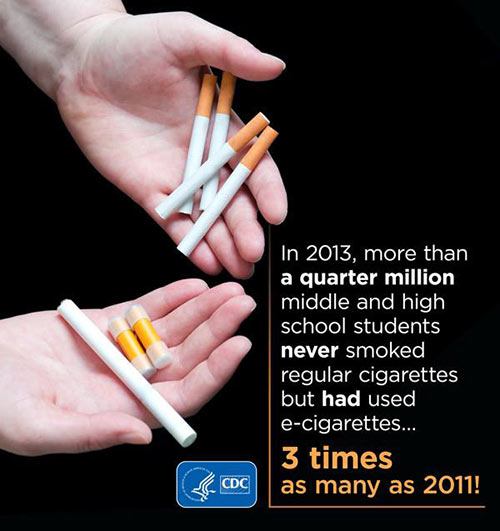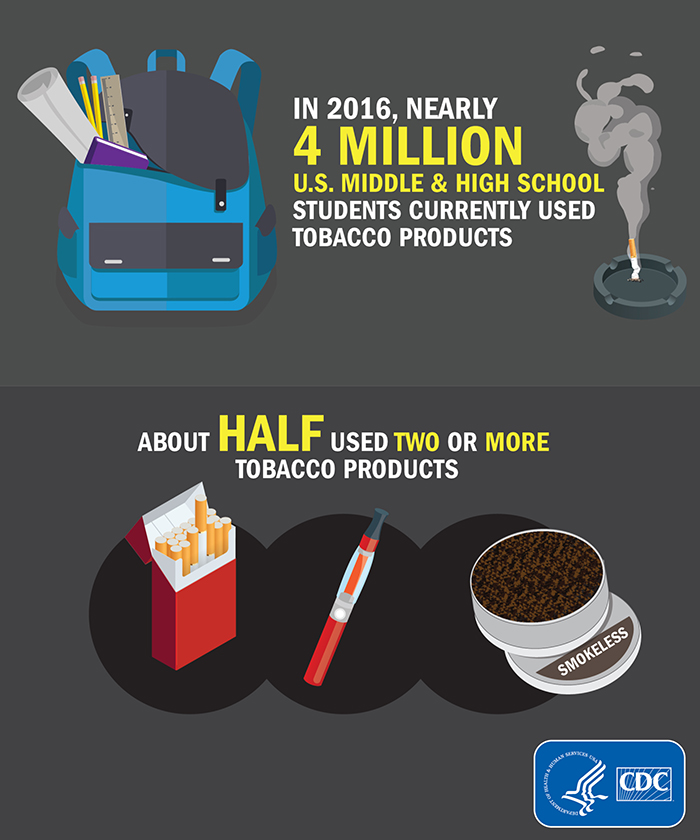Hookahs and Ecigs
Seeing Through The Smoke—E-cigarettes Are Hazardous to Your Health
There is a growing misconception that e-cigarettes are a safe alternative to regular cigarettes. When the smoke clears, however, the facts tell a different story:
- Most electronic cigarettes contain the addictive chemical nicotine, which increases the risk of high blood pressure and diabetes.
- Some e-cigarettes contain formaldehyde, the same chemical used in building materials and anti-freeze.
- The flavoring agent diacetyl, which is often added to foods like popcorn, can be dangerous when inhaled. Studies show it has been associated with a rare lung disease called bronchiolitis obliteransthat causes permanent damage to the bronchioles.
 According to the U.S. Surgeon report, e-cigarettes are now the most commonly used tobacco product among youth, surpassing regular cigarettes since 2014. 1 Access to e-cigarettes has become a serious adolescent public health issue given the rapid rise in youth use of e-cigarettes in the U.S., including a 900% increase among high school students from 2011 to 2015.1
According to the U.S. Surgeon report, e-cigarettes are now the most commonly used tobacco product among youth, surpassing regular cigarettes since 2014. 1 Access to e-cigarettes has become a serious adolescent public health issue given the rapid rise in youth use of e-cigarettes in the U.S., including a 900% increase among high school students from 2011 to 2015.1
How About Hookahs…Are They Safe?
Hookahs—water pipes that are used to smoke tobacco—are no safer than e-cigarettes. Still, they have become extremely popular among our nation’s youth due to a misconception that the devices emit purely water vapors.
Because of the way a hookah is used, smokers may inhale more of the toxic substances than if they were smoking a cigarette. For example, a one-hour hookah smoking session involves about 200 puffs, while smoking an average cigarette involves just 20 puffs. 3
 Nationally, 9.4% of high school students smoked hookah in 2014, vs. 5.2% in 2013; 2.5% of middle school students smoked hookah in 2014 vs. 1.1% in 2013. 2 Hookah is now the most commonly used tobacco product after e-cigarettes for adolescents. In New Jersey, 8.4% of high school students reported smoking hookah. 3
Nationally, 9.4% of high school students smoked hookah in 2014, vs. 5.2% in 2013; 2.5% of middle school students smoked hookah in 2014 vs. 1.1% in 2013. 2 Hookah is now the most commonly used tobacco product after e-cigarettes for adolescents. In New Jersey, 8.4% of high school students reported smoking hookah. 3
The negative health effects of hookah are significant:
- Heart disease
- Lung cancer
- Bladder cancer, and
- Oral cancer
Non-Tobacco Hookahs Are OK, Right?
Wrong. Non-tobacco hookah products still pose health risks to adolescents.4 Smoke from preparations of tobacco-based shisha and non-tobacco “herbal” shisha contain carbon monoxide and other toxic agents known to increase the risks for smoking-related cancers, heart disease, and lung disease.5,6
In Paterson, almost 30% of youth surveyed by P-CASA admitted to using hookah within the past 30 days. There is a gender disparity present where 33.7% of adolescent males reported using hookah compared to 25.9% of adolescent females in Paterson.
What are E-cigarettes?
E-cigarettes are defined as “an electronic device that can be used to deliver nicotine or other substances to the person inhaling from the device, including, but not limited to, an electronic cigarette, cigar, cigarillo, or pipe.”1
These devices deliver nicotine, flavorings, and other additives to users via an inhaled aerosol. These devices are often called “e-cigs,” “e-hookahs, “mods,” “vape pens,” and “vapes”.

P-CASA is working to build a better Paterson.
P-CASA understands the importance of decreasing the number of e-cigarettes and hookah being consumed by Paterson adolescents. With that in mind, we are:
- Developing social media marketing and education campaigns that inform and educate the community on the impact of e-cigarette and hookah use.
- Establishing relationships with local servers and sellers of tobacco to learn the latest trends in selling tobacco products to minors, including the sale of loose or single cigarettes, smokeless tobacco, and hookah pens.
For more information about e-cigarettes and youth, click here.
References:
- E-Cigarette use Among Youth and Youth Adults. (2016). A Report of the Surgeon General. Retrieved from: https://e-cigarettes.surgeongeneral.gov/documents/2016_SGR_Exec_Summ_508.pdf
- Hookah.(2016). Centers for Disease Control and Prevention. Retrieved from: https://www.cdc.gov/tobacco/data_statistics/fact_sheets/tobacco_industry/hookahs/index.htm
- Hazards of Hookah Smoke: Dangers of Use and Exposure. NJ GASP. Retrieved from: http://www.njgasp.org/wp-content/uploads/2014/05/GASP-Hookah-trifold-in-english-7-15-15-final.pdf
- American Lung Association. Hookah Smoking: A Growing Threat to Public Health Issue Brief. Smokefree Communities Project, 2011. Retrieved from: http://www.lung.org/assets/documents/tobacco/hookah-policy-brief-updated.pdf
- Shihadeh A, Salman R, Eissenberg T. Does Switching to a Tobacco-Free Waterpipe Product Reduce Toxicant Intake? A Crossover Study Comparing CO, NO, PAH, Volatile Aldehydes, Tar and Nicotine Yields. Food and Chemical Toxicology 2012; 50(5):1494–8
- Blank MD, Cobb CO, Kilgalen B, Austin J, Weaver MF, Shihadeh A, Eissenberg T. Acute Effects of Waterpipe Tobacco Smoking: A Double-Blind, Placebo-Control Study. Drug and Alcohol Dependence 2011;116(1–3):102–9
